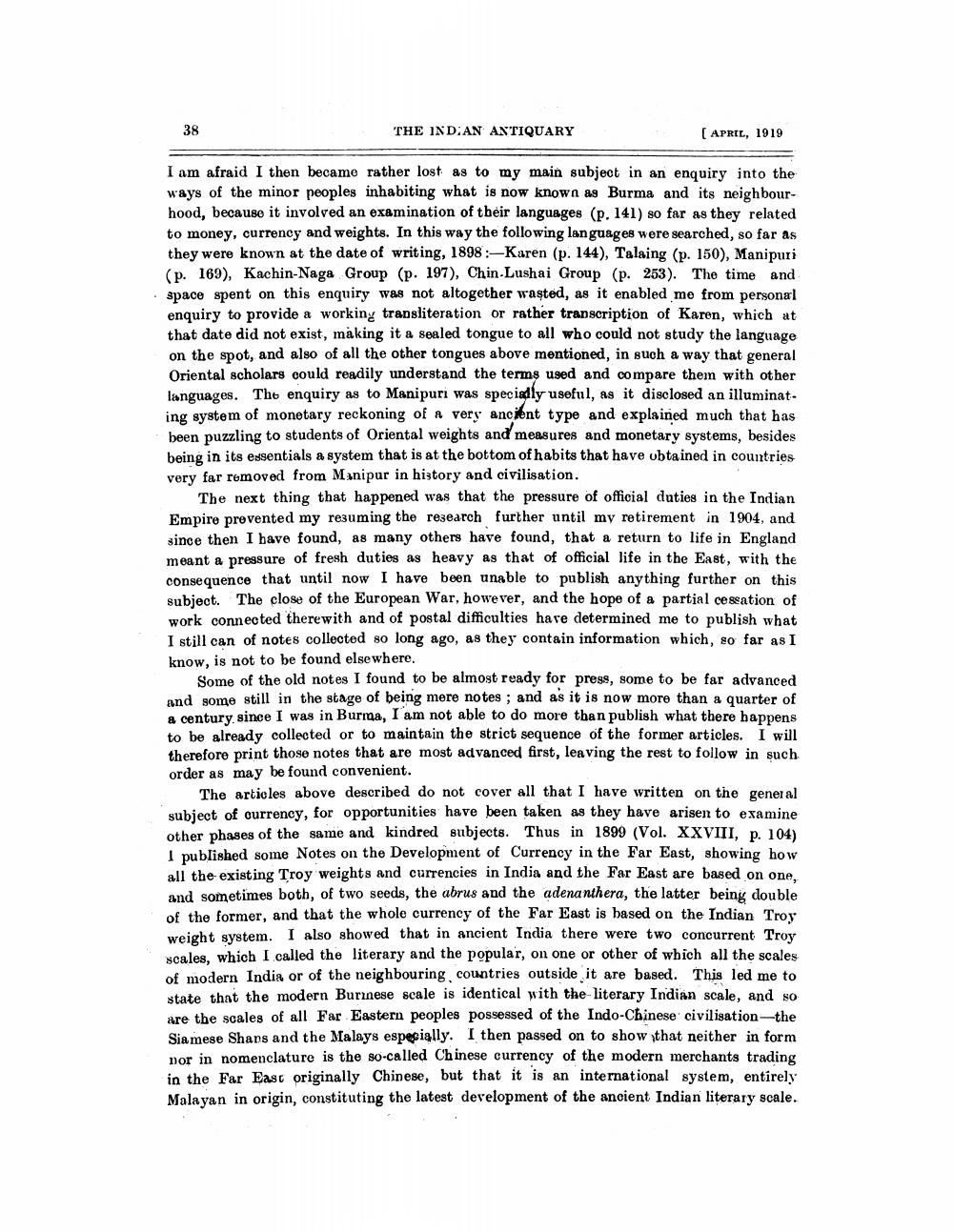________________
38
THE INDIAN ANTIQUARY
(APRIL, 1919
I am afraid I then became rather lost as to my main subject in an enquiry into the ways of the minor peoples inhabiting what is now known as Burma and its neighbourhood, because it involved an examination of their languages (p. 141) so far as they related to money, currency and weights. In this way the following languages were searched, so far as they were known at the date of writing, 1898 Karen (p. 144), Talaing (p. 150), Manipuri (p. 169), Kachin-Naga Group (p. 197), Chin-Lushai Group (p. 253). The time and space spent on this enquiry was not altogether wasted, as it enabled me from personal enquiry to provide a working transliteration or rather transcription of Karen, which at that date did not exist, making it a sealed tongue to all who could not study the language on the spot, and also of all the other tongues above mentioned, in such a way that general Oriental scholars could readily understand the terms used and compare them with other languages. The enquiry as to Manipuri was speciedly useful, as it disclosed an illuminat. ing system of monetary reckoning of a very ancient type and explained much that has been puzzling to students of Oriental weights and measures and monetary systems, besides being in its essentials a system that is at the bottom of habits that have ubtained in countries very far removed from Manipur in history and civilisation.
The next thing that happened was that the pressure of official duties in the Indian Empire prevented my resuming the research further until my retirement in 1904, and since then I have found, as many others have found, that a return to life in England meant a pressure of fresh duties as heavy as that of official life in the East, with the consequence that until now I have been unable to publish anything further on this subject. The close of the European War, however, and the hope of a partial cessation of work connected there with and of postal difficulties have determined me to publish what I still can of notes collected so long ago, as they contain information which, so far as I know, is not to be found elsewhere.
Some of the old notes I found to be almost ready for press, some to be far advanced and gome still in the stage of being mere notes; and as it is now more than a quarter of a century since I was in Burma, I am not able to do more than publish what there happens to be already collected or to maintain the strict sequence of the former articles. I will therefore print those notes that are most advanced first, leaving the rest to follow in such order as may be found convenient.
The articles above described do not cover all that I have written on the general subiect of currency, for opportunities have been taken as they have arisen to examine other phases of the same and kindred subjects. Thus in 1899 (Vol. XXVIII, p. 104) I published some Notes on the Development of Currency in the Far East, showing how all the existing Troy weights and currencies in India and the Far East are based on one. and sometimes both, of two seeds, the abrus and the adenanthera, the latter being double of the former, and that the whole currency of the Far East is based on the Indian Troy weight system. I also showed that in ancient India there were two concurrent Troy scales, which I called the literary and the popular, on one or other of which all the scales of modern India or of the neighbouring, countries outside it are based. This led me to state that the modern Burinese scale is identical with the literary Indian scale, and so are the scales of all Far Eastern peoples possessed of the Indo-Chinese civilisation-the Siamese Shans and the Malays especially. I then passed on to show that neither in form nor in nomenclature is the so-called Chinese currency of the modern merchants trading in the Far East originally Chinese, but that it is an international system, entirely Malayan in origin, constituting the latest development of the ancient Indian literary scale.




